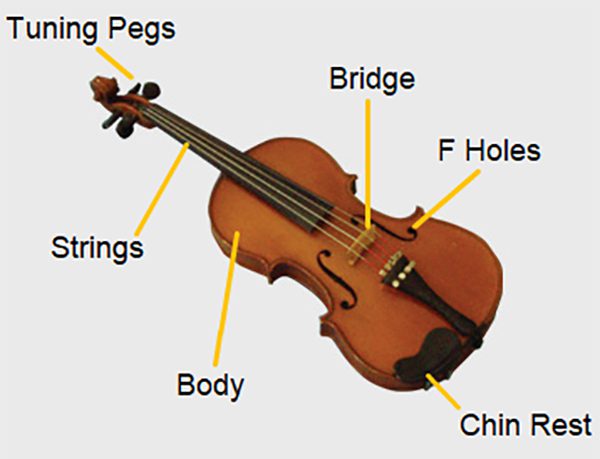The violin is the smallest member of the string family. It has the most brilliant quality of all the stringed instruments. There are usually 20 or more violins in an orchestra which is more than any other single instrument. The violins play in two different groups, with the first violins playing the highest-pitched part and the second violins playing the second highest. The violin has a very vast range. Its tone is sweet and clear, and it sounds good in solos because it can be heard easily above a big orchestra.
The violin is played by resting the instrument on the left shoulder and holding it in place using the chin and left hand. The bow is held in the right hand and is drawn across the strings. The pitch is changed in two ways: by drawing the bow across different strings and by pressing on the strings with the fingers of the left hand.
The body of the violin is made of wood and is hollow so it can vibrate to amplify the sound of the strings. The shape of the body gives the violin its distinctive tone. The body of a full-size violin is usually about 14 inches long.
The neck extends out one end of the body. On the neck is the fingerboard. There are four strings stretch across the body and fingerboard of the violin, from one end to the other. They are made of steel, nylon, or gut, and each is tuned to a different pitch. The violin has four tuning pegs – one for each string. The upper ends of the strings are wound around these wooden pegs. They can be turned to tighten or loosen the strings, changing the pitch. The tailpiece attaches the strings to the other end of the violin. The bridge supports the strings and transmits their vibrations to the body of the violin. It is made of wood and is curved so that you can bow each string separately. The sounds holes are called f-holes because of their shape. They help the body of the violin to vibrate and help the vibrating air to escape from inside the instrument. This makes the violin sound louder. The chin rest is a curved cup that makes it more comfortable to hold the instrument under the chin. The bow is made of horsehair attached to a rod. When the horsehair touches the strings of the violin, the strings vibrate, creating a pitch.
Violinists use special techniques to produce a wide variety of sounds. For instance, they might pluck the strings instead of bowing them. This is called pizzicato. Or they might play double stops, which means playing chords by bowing two strings at the same time.

